Introduction
The most comprehensive academic historical text on the kibbutz is Henry Near’s The Kibbutz Movement: A History (2007), in which the two-volume book offers an analytical overview of the kibbutz from 1909 to 1995, including ideological, political, economic and social aspects. No research endeavour seeking to generally describe the immense phenomenon of the kibbutz could neglect to cite Near’s words. Kibbutz (pl. kibbutzim, coll. the kibbutz) is a collective form of society in Israel with a spirit of close community and co-operation. Participation in a kibbutz is voluntary, and its governance is assured by all of its members via methods of direct democracy. The source of authority is achieved by way of general meetings of all the members in which all the important decisions are made. Most of the kibbutzim members are Jewish; however, for the great majority, Judaism is a cultural or national expression rather than one of religious faith or practice (Near, 2007: 1).
The first kibbutz was founded in 1909, and by the late 1940s, following the establishment of the State of Israel, there were dozens of kibbutzim across Israel (Near, 2004: 7). Kibbutzim were founded mostly by European Jewish youth who immigrated to Palestine to pursue a Zionist version of socialism (Near, 2007: 3). Therefore, from the outset of the kibbutz, the two theoretic and practical pillars present were those of Zionism and socialism.
Near explains the geo-political context in which the foundation of kibbutzim should be understood. For those who established the kibbutzim in the early twentieth century, “practical Zionism” - the view that Jewish nationhood could only be revived by settling the Land of Israel - was a central and elementary assumption. Two key events in the early twentieth century led this Zionist assumption to be even more unquestioned: the Balfour Declaration during First World War in which the British government announced its support for the establishment of a national home for the Jewish people in Palestine, and later the rise of Nazism and the closing of other borders to persecuted Jews (Near, 2007: 2).
The second theoretic and practical pillar of the kibbutz was the international socialist movement. The kibbutz movement is based on socialist values of equality among all people, and conceptual and financial cooperation (Palgi and Reinharz, 2011a: 3). In their early days, kibbutz members glorified Marxism (ibidem) despite the fact they were not traditional Marxists, identifying their way of life as proposing an alternative to the capitalist system (Gan, 2011: 34). The kibbutz movement defined itself as an exemplary society striving to serve as a utopian model for the entire State of Israel upon its establishment (Near, 2011: 197). And indeed, in the Israeli consciousness, for many years, the kibbutz’s image was of one of the founding forces of the Israeli State (Near, 2007: 3).1
It should be noted that in this text the generalizations “the kibbutz” or “the kibbutz movement” are used while presenting examples mainly from Hakibbutz Ha’artzi. Hakibbutz Ha’artzi was one of the four kibbutz movements at that time, operated under the title “the kibbutz movement”, and each of them had different ideological emphases.2 As a result of the different emphases, the social status and role of artists differed slightly in each movement.3 I find the Hakibbutz Ha’artzi most intriguing in examining the status and role of kibbutz artists since it had a more radical approach than the others, and this provides the reason why this specific kibbutz is the focus of my study. Nevertheless, I use the generalizing term of “the kibbutz” since I suspect my analysis of Hakibbutz Ha’artzi’s art and artists could reflect the role of art in the kibbutz movement in general. Furthermore, the use of generalizing terms while talking about a specific movement is common and accepted in the kibbutz research literature.
Since their establishment and up to present day, kibbutzim went through many changes and transformations.4 This paper will explore and discuss what is commonly called the “classical kibbutz”, referring to the kibbutz as it existed before its fundamental transformation in the 1980s, which brought with it a harsh economic, ideological and social crisis on the kibbutz, leading to many changes touching on all aspects of life - from mundane everyday issues to questions of principles and values (Pauker, 2011: 20). For the purpose of clarity, the beginning of the time frame of this paper is not the beginning of the kibbutz movement in 1909, but rather 1935, the year in which the founding conference of the Association of Kibbutz Painters and Sculptors took place. In the literature, this year signifies the beginning of kibbutz art (Danieli, 2001: 65); therefore, it will signify the beginning of the discussion regarding the status, role and artworks of kibbutz women artists.
For many reasons kibbutz society caught the attention of international scholars given how it was viewed as a social experiment (see Palgi and Reinharz, 2011b: xi), but to the best of my knowledge, it has never been intersected thoroughly with Eric Olin Wright’s writings. In his book Envisioning Real Utopias, Wright briefly mentioned the kibbutz twice, first as an example of social ownership (2010: 76), and second, in a footnote connected to problems of non-capitalistic institutions functioning in a capitalist environment (ibidem: 152). Wright, who focused on the economic aspects involved in realising real utopias in the future, did not look back to kibbutz society as a phenomenon for reference.5 He presented several contemporary alternative societies that correspond to his theory of real utopias (chapters 6-7), and this paper will argue that Wright’s theory equally corresponds to the historic example of kibbutz. The kibbutz correlates with Wright’s ideas in several aspects, the most relevant of which being his “radical democratic egalitarian understanding of justice” (Wright, 2010: 8; italics in the original).
This paper will demonstrate how Wright’s definitions of social justice and political justice within a social institution existed in classical kibbutz society, especially from the aspect of gender. Since this will be the first paper to analyse Wright’s thoughts on genderlessness in regards to kibbutz society in general, and to kibbutz women artists in particular, it will address the appearance of genderlessness in the social status, role and artworks of kibbutz women artists. It will not investigate the women artists’ stand towards this genderlessness, an investigation that could be addressed in future research.
The paper will start with analysing how Wright defined a socially just society and the issue of genderlessness. Then, through social-historical examination using archival evidence and based on personal interviews conducted with artists, the paper will claim that Wright’s definitions corresponded the social status and role of kibbutz women artists. Afterwards, using artistic analysis, the paper will assert that genderlessness is also expressed as a theme in artworks of kibbutz women artists. These methods will supply an interdisciplinary understanding of how the kibbutz, at least in the aspect of its artists, could be used as an example of a genderless society, following Wright’s thought.
Wright’s Just Society and Genderlessness
Wright presented two principles for a just society, principles that should ideally occur in his utopian model of society and which are used as a foundation for his analysis of a social institution:
Social justice: In a socially just society, all people would have broadly equal access to the necessary material and social means to live flourishing lives.
Political justice: In a politically just society, all people would have broadly equal access to the necessary means to participate meaningfully in decisions about things which affect their lives. This includes both the freedom of individuals to make choices that affect their own lives as separate persons, and their capacity to participate in collective decisions which affect their lives as members of a broader community. (Wright, 2010: 8)
The principle of political justice, as articulated by Wright, existed on the kibbutz from a gender point of view. Several scholars have claimed that in political and financial-juridical aspects, gender equality was also prevalent (see in Fogiel-Bijaoui, 1992: 211). Since their early days, women’s financial and legal standing on the kibbutz was autonomous and non-dependent on their fathers or husbands. Furthermore, women had the right to vote and to stand for election; in addition, they had the right to participate in the general assembly and to be involved in the community’s decision-making (Near, 2011: 110).6 Moreover, kibbutz women benefited from shared collective facilities (such as children’s houses,7 kitchen and dining room, laundry service), which removed the burden of housekeeping and reduced the constant tension between the role of women as devoted mothers and wives and their role as contributing working women (Near, 2007: 50). These are the true achievements of the kibbutz movement. However, more recent studies have focused on the discrimination of kibbutz women on the basis of what Wright would call social justice (see, for example, Fogiel-Bijaoui, 2010, 2013; Fogiel-Bijaoui and Sharaby, 2017; Shilo, 2014; Sinai, 2013).
Having defined a socially just society as holding “equal access to the necessary material and social means to live flourishing lives” (Wright, 2010: 8), Wright explained two key components of this definition. The first is the idea of flourishing, which refers to “the various ways in which people are able to develop and exercise their talents and capacities, or, to use another expression, to realize their individual potentials” (ibidem: 9). He then elaborated on the necessary social and material means to which he referred:
The importance of material resources for human flourishing is obvious. Certainly without things like adequate nutrition, housing, clothing, and personal security it is difficult for most people to flourish in either the restrictive or expansive sense. But the development of intellectual, physical and social capacities requires much more than simple material necessities. It requires access to educational settings within which learning takes place and talents are cultivated, not just in childhood, but throughout life. It requires access to work settings where skills can be developed and exercised and activity is to a substantial extent self-directed. It requires communities which provide opportunities for active participation in civic affairs and cultural activities. (ibidem: 10)
This paper does not take upon itself the tremendous task of claiming that women on the kibbutz in general experienced social justice, but it will argue that women artists had equal social justice when compared to their male artist counterparts. The paper will even take this notion a step forward and argue that the social status, role and artworks of women artists on the kibbutz expressed genderlessness, as defined by Wright (2011) in his paper “In Defense of Genderlessness”.
The idea of genderlessness was developed by Wright as a key ideal to a just society. In “In Defense of Genderlessness”, Wright used nurturance as a case study, but this paper will address only his basic thesis that the dissolution of gender is the ultimate goal of an egalitarian society (ibidem: 403), and examine it through a different case study. Wright recognized a distinction between gender equality and genderlessness and stated that the main difference is their aspiration. While for gender equality the aspiration is to acknowledge the difference between the social roles and characteristics of men and women and to neutralize them through institutional devices, the aspiration of genderlessness is to demolish this differentiation altogether (ibidem: 408-409). Another distinction he made is between the genderless society and sexless society. A genderless society does not mean that a person’s sex would not correspond to their social roles, or in Wright’s words “that everyone would be androgynous in their identities and practices in the absence of gender relations. There would still be behaviors and dispositions that correspond to what we now view as feminine and masculine” (ibidem: 405). Rather, what would disappear is the “systematic normative expectation” of this correlation, or its promotion by normative sanctions (ibidem). Wright clarified these distinctions to deepen his argument that a society with gendered norms will establish socially imposed constraints on the preferences and practices of men and women, constraints which prevent the ideal of a socially just society in which all people have “equal access to the social material means necessary to live a flourishing life” (ibidem: 403). Therefore, a society with degendered norms will be much more socially just.
Social Justice on Kibbutz: The Artists’ Perspective
In order to demonstrate how women artists on kibbutz experienced social justice equal to that of their male artist counterparts, it is first necessary to analyze how kibbutz was socially just towards its artists in general. Kibbutz artists definitely had “equal access to the necessary material and social means to live flourishing lives” (Wright, 2010: 8) - “equal” in relation to all other kibbutz members. This is not to be taken lightly, since artists were truly “the other” in kibbutz society in terms of their share in the collective labor force. Labor, defined as the physical act of working, was one of the basic values of kibbutz ideology (Palgi and Reinharz, 2011a: 3-4). In a society that glorified the laborer, those who worked in agriculture, built the settlement, took care of the children and prepared the food might well view or treat those involved in the plastic arts as parasites. This is especially true since artists were given the right to so-called “art days” where they did not go to work like all other kibbutz members but were allowed to dedicate their time to their art (Danieli, 2001: 65).8 While studies on the subject tend to focus on artists that personally felt they had been treated as parasites (for example, Danieli, 2001, 2010; Tsur, 2007), in reality, these artists were treated as equals in terms of social rights to all the other kibbutz members.9
In terms of necessary material means, kibbutz artists enjoyed far greater access to resources available to other artists at that time, i.e. Israeli artists not living on kibbutz. The kibbutz, serving as a financial collective among other collective aspects, provided each member with the material resources that Wright (2010: 10) described: food was cooked in the collective kitchen and served in the collective dining room every day, housing was provided by the kibbutz, clothing was sewn by the sewing workshop and cleaned at the collective laundry, and kibbutz members shared guard duty in rotation to provide security. All these services and facilities were a part of the network of collective facilities the kibbutz operated (Doron, 2011: 104). In terms of necessary social means, kibbutz artists also enjoyed the components that Wright (2010: 10) spoke about: they had professional conferences and seminars where they were taught by some of the leading artists in Israel at that time; kibbutzim sent their artists and paid their tuition to study art at Israeli and international art academies; many artists were given studios, workshops and creative materials; they participated in annual exhibitions especially conceived for them where they could display their artworks; and, they always actively participated in the cultural activities of the kibbutz movement.10 Considering these aspects, kibbutz artists led far more “flourishing lives” (as Wright would define it) than other Israeli artists living outside the kibbutz, who lacked such community support to sustain themselves. This is particularly true during the period of hardship and insecurity experienced before the establishment of the State of Israel in 1948 and would continue for the first twenty or so challenging years of the new-born State.
The Genderless Status and Role of Kibbutz Women Artists
The status of women artists on kibbutz was equal and in keeping with what has been described above. Interviews conducted as part of this study, along with archival evidence, show that women artists were provided with the same material and social means as their male counterparts. This fact is astonishing when one considers the status of women artists outside the kibbutz, especially in the years before the 1960s and the second-wave feminism. As a result of the political and social structure of the kibbutz, female kibbutz members were miles apart from the women described in Simone de Beauvoir’s Le deuxième sexe (1949) or the women in Betty Friedan’s The Feminine Mystique (1963). They did not confront the obstacles of earning less money than men, facing domestic responsibilities or dealing with dependence on their husbands, nor did they have to fulfill the limiting roles of homemakers and mothers. As a result of the rights of artists defined at the founding conference of the Association of Kibbutz Painters and Sculptors, kibbutz women artists did not suffer from what Linda Nochlin (1988) defined in her pioneering essay on feminist art history and theory as “institutional” prejudice and obstacles, preventing them from fulfilling their artistic wishes, at least not on the level of kibbutz institution. As a result of the “art days” and studios appointed by the kibbutz, kibbutz women artists had the time and space necessary for artistic creation, similar to what is mentioned and pursued by Virginia Woolf in A Room of One’s Own (1929) and bell hooks in Art on My Mind (1995).
Thus, kibbutz ideology created degendered norms towards its artists with regard to their social status. Moreover, not only was the social status of kibbutz women artists equal to their male counterparts, so was the role of their art. Defined at the founding conference of the Association of Kibbutz Painters and Sculptors in 1935, the artists declared that their art is obliged to adhere to kibbutz values, and that they will use their art to glorify these values and to serve the needs of the kibbutz movement (Danieli, 2001: 68). In this way, the role of kibbutz artists became a tool in the ideological and political struggle of the kibbutz movement. Both men and women artists responded to this role in the same two ways, by creating artworks that: (1) wished to glorify and spread the values of the kibbutz movement; and, (2) wished to serve the internal needs of the kibbutz from the aspect of the welfare of kibbutz members.
Artworks aiming to glorify and spread kibbutz values presented similar themes and were created with similar mediums in the artworks created by both male and female kibbutz artists. Many created linocuts which were published in Hedim, a journal which dealt with issues concerning the kibbutz movement. Their linocuts had the quality of documentary art (Danieli, 2001: 66), documenting life on kibbutz and the Zionist experience of pioneer settlements. One of the central topics portrayed in their linocuts was the agricultural perspective of kibbutz life, a pivotal development in a society which needed to sustain itself and establish new settlements. Genija Valdberg (1910-1992) from Kibbutz Bet Zera was one of the earliest women artists to express the artistic role of glorifying and spreading kibbutz values this way. Her linocut “Agricultural Work” (Figure 1) documents an agricultural perspective of kibbutz, and her linocut “Kibbutz Ein Hakore Builds Its Settlement” (Figure 2) documents the establishment of a new kibbutz.
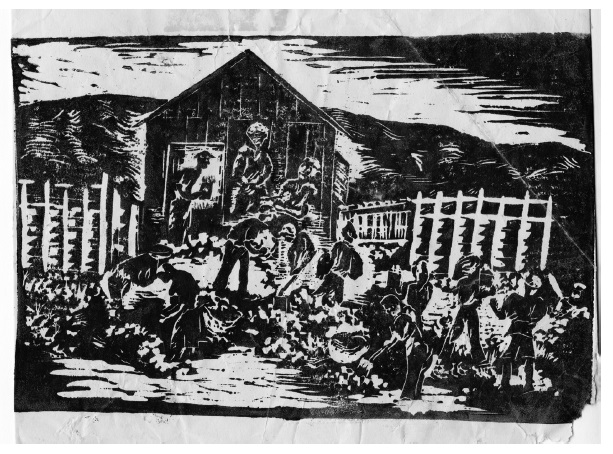
Copyright: Bet Zera Archive.
Figure 1 Genija Valdberg, “Agricultural Work”, 1935-1953, 15x20 cm, linocut
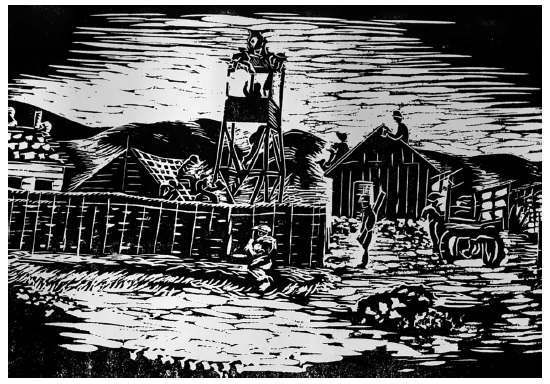
Copyright: Bet Zera Archive.
Figure 2 Genija Valdberg, “Kibbutz Ein Hakore Builds Its Settlement”, 1937, 15x20 cm, linocut
Artworks that aimed to serve the needs of the kibbutz from within varied in medium and theme but all had the same purpose - to contribute to the welfare and well-being of the kibbutz members. Women and men artists were assigned the role of making life on kibbutz more aesthetically pleasing. They decorated public buildings and spaces within the kibbutz with their artworks and were responsible for designing bulletins and billboards - central components of kibbutz life, where members would gather to get caught up on news and socialize. They were also responsible for the aesthetic aspects of all cultural events held on the kibbutz (Danieli, 2010: 265). Chana Behor (1910-2007) from Kibbutz Ma’abarot was one of the earliest women artists to express the artistic role of contributing to the welfare and well-being of kibbutz members this way. As a sculptor and ceramist, dozens of her sculptures were placed on the public lawns of her kibbutz (for example, Figure 3), and dozens of her ceramic reliefs were hung on public buildings, especially the children’s houses (for example, Figure 4). In her diaries, Chana Behor talks with great pride about her art decorating the “kibbutz home”. She sees herself as having the important role of enriching the lives of the kibbutz members and of turning the kibbutz into a more beautiful and pleasant home.11
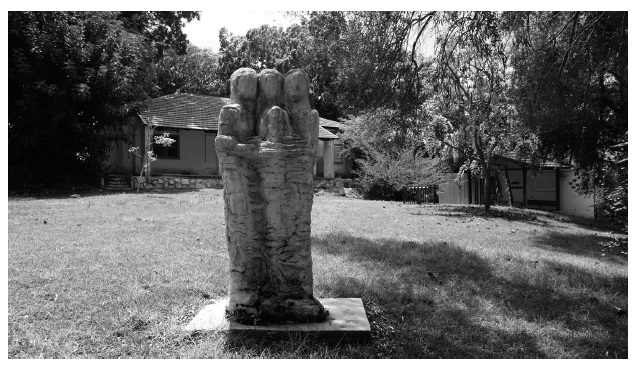
Credits: Ruth Yurovski, 2019.
Figure 3 Chana Behor, “The Three Sisters”, 1940s, 164x65x23 cm, concrete, Kibbutz Ma’abarot
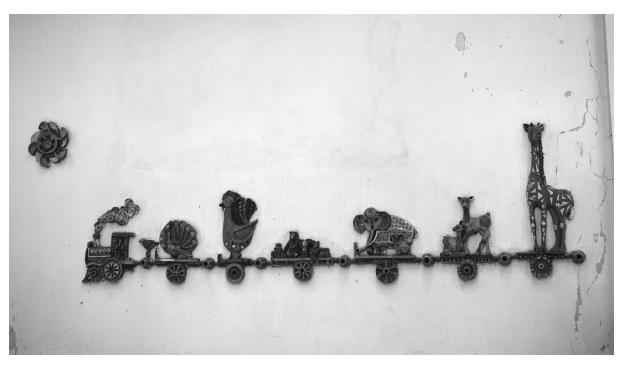
Credits: Ruth Yurovski, 2019.
Figure 4 Chana Behor, “The Animal Train”, 1940s, 67x230 cm, ceramic relief, decorating a children’s house in Kibbutz Ma’abarot
As the years passed, the kibbutzim no longer needed to spread and glorify their values so vigorously. Their pioneering task which resulted in the establishment of the State of Israel in 1948, and its initial stages of development, drove the kibbutz movement to become one of the strongest economic and political forces in Israel. The experiment of Zionist socialism seemed to have become a true success story (Near, 2004: 8). Thus, at this stage of their development, the role of kibbutz artists on kibbutzim was no longer required to be employed as a tool for the ideological and political struggle of the kibbutz movement. Nevertheless, the social status of artists remained as it was, which enabled more and more women artists to fulfill their artistic aspirations.
Genderlessness in Artworks of Kibbutz Women Artists
In the years to come, the genderlessness expressed in the status and role of kibbutz women artists would also appear in their artworks.12 If in the 1930s and 1940s most women artists (and kibbutz members in general) were immigrants who established and built the kibbutz, developing the practical and ideological way of life there, by the 1960s and onwards women artists were being born and raised on kibbutz, educated by and living their whole lives according to its ideology (Danieli, 2010: 269). Therefore, for these artists genderlessness was an integral, almost obvious, visual theme for depicting kibbutz life. In examples of artworks made by these women artists, genderlessness can be seen most explicitly in works depicting images of men and women on the kibbutz together. In these artworks, the appearance of men and women is unified, usually taking on a more male like appearance. The following examples of artworks by kibbutz women artists Idit Levavi Gabbai (b. 1953) from Kibbutz Merhavia, Marion Fuchs (b. 1948)13 from Kibbutz Metzer, and Tzila Liss (b. 1945) from Kibbutz Ein Shemer present this visual theme.
“Body” (Figure 5) is a manipulated photograph by Idit Levavi Gabbai which presents the founders of her kibbutz on the ceremonial day in 1929 when the kibbutz was officially established. In the photograph, adult pioneers and children stand and sit in lines, all dressed in white festive clothing. Underneath, the Hebrew word for “body” is written. The whole community is presented as one body - on a physical level and on a group level. It is difficult to determine whether the men and women are dressed in identical clothing, but their appearance is quite similar. Levavi Gabbai presents and refers to men and women in a unified form - with no gender distinctions. She developed the concept of unified body in her installation “Inside-Out Room” (Figure 6). The row of towels in the installation is a conceptual presentation equivalent to the rows of members in “Body”. The installation, exhibited at the exhibition “Togetherness: The ‘Group’ and the Kibbutz on Collective Israeli Consciousness” at the Tel Aviv Museum of Art in 2005, deals with the experiences of artists from the children’s houses on the kibbutz. The row of towels was an actual row in children’s houses - towels to either dry your hands after washing them or dry your body after a communal shower. With the row of towels, Levavi Gabbai expressed the feeling of unity - the towels are of the same height, are the same for boys and girls, arranged in a systematic assembly line like way, meaning - all are equal, all are the same. The towel in itself is an object that implies body, since it holds within it the context of body. In her analysis of Levavi Gabbai’s prominent work, “A Pioneer Woman’s Eyes #2” (Figure 7), well known Israeli art curator, Tali Tamir, stated that over the history of Levavi Gabbai’s entire oeuvre, the towel is also directly linked to concealing the uniqueness of the female body (Tamir apudGuilat, 2011: 136). Altogether, this installation expresses how the appearance of the bodies of boys and girls is unified.
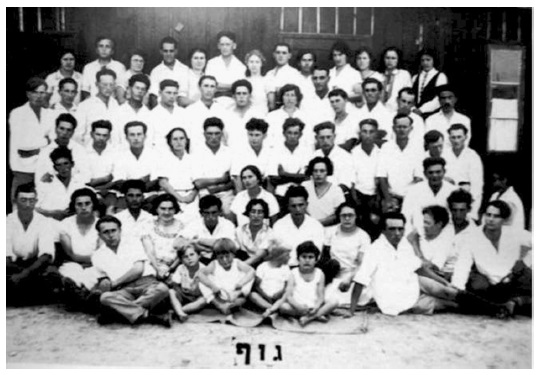
Copyright: Idit Levavi Gabbai. Source: Shapira (2011: 34).
Figure 5 Idit Levavi Gabbai, “Body”, 1997, 30x40 cm, manipulated photograph, artist’s collection, Kiryat Tiv’on
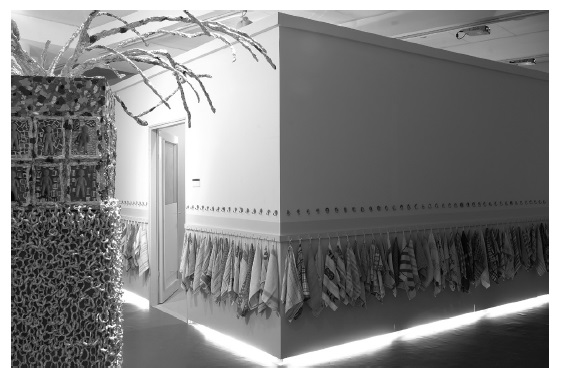
Copyright: Idit Levavi Gabbai. Photography: Avraham Hay. Source: Shapira (2011: 44).
Figure 6 Idit Levavi Gabbai, “Inside-Out Room”, 2005, installation, mixed media, Helena Rubinstein Pavilion for Contemporary Art, Tel Aviv Museum of Art, Tel Aviv
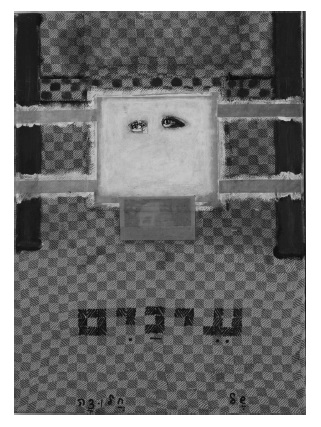
Copyright: Idit Levavi Gabbai. Source: Shapira (2011: 30).
Figure 7 Idit Levavi Gabbai, “A Pioneer Woman’s Eyes #2”, 1994, 40x30 cm, mixed media on canvas, Ein Harod Museum of Art, Ein Harod
This genderless unity also exists in Marion Fuchs’s series, “The Group”. The series of oil on canvas paintings was inspired by group photographs of the Zionist youth movement in pre-Holocaust Poland, photographs of Fuchs as a girl in the Hashomer Hatzair movement,14 and photographs of her everyday life on kibbutz from the past (Hinsky Amitay, 2019). Her motivation for painting these group portraits was derived from personal contemplation,15 but the result was a repetitive exploration of the united body of the group image - the body of “us”, as referenced by curator Tali Tamir (2005: 44). The painting from this series “The Zionist Youth 2” (Figure 8) depicts a group of Jewish youth in Poland, several years before the Holocaust. The painting greatly resembles Idit Levavi Gabbai’s “Body” in the way that all members of the group are standing or sitting in rows, all dressed in uniforms of the movement, looking quite similar to each other. Being fully identified with the group as a whole leaves no room for individualism, including differences in gender. The girls and boys in the painting are dressed the same, sit side by side as equals, genderless in their appearance. “The Dairy Farmers” (Figure 9) is another painting from “The Group” series, this time an example of a later group portrait, based on photographs from Fuchs’s daily life on the kibbutz. In “The Dairy Farmers” six kibbutz farmers are presented, one of whom is a woman. The woman appears no different to the men - she is dressed like them and she works together with them. The painting resonates the kibbutz ideal of a genderless division of labor, where men and women do the same work (Tiger and Shepher, 1983: 29).
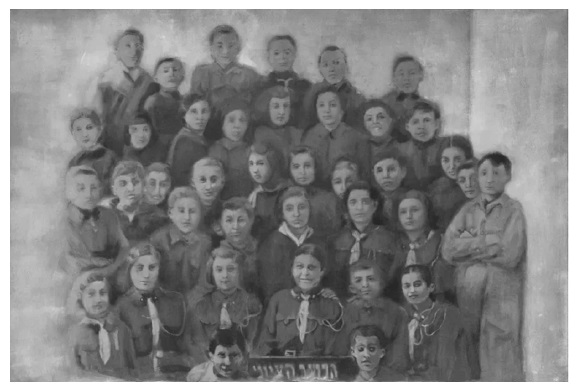
Copyright: Marion Fuchs. Source: https://www.marionfuchs.co.il/.
Figure 8 Marion Fuchs, “The Zionist Youth 2”, 2002, 80x120 cm, oil on canvas, artist’s collection, Kibbutz Metzer
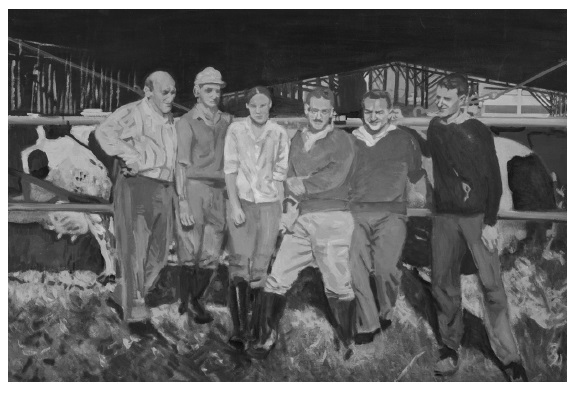
Copyright: Marion Fuchs. Source: https://www.marionfuchs.co.il/.
Figure 9 Marion Fuchs, “The Dairy Farmers”, 2002, 80x120 cm, oil on canvas, artist’s collection, Kibbutz Metzer
While the artworks by Idit Levavi Gabbai and Marion Fuchs - presenting the subject of genderlessness in kibbutz life - do not clearly reveal the artists’ stand towards it, Tzila Liss’s visual analysis of this genderlessness is distinctively critical. Tzila Liss’s installation “Traveling through Fragmented Time” (Figures 10 and 11) presents a journey which derived from the urge she felt to be “on the go”, even though she never was.16 Apart from a three-year stint in Belgium, she never left the kibbutz. In many of her artworks, Liss criticizes the kibbutz, and this installation upholds her criticism. The installation features dozens of white papier-mâché figures, all of them designed as anonymous-genderless figures, even though they represent male and female members of the kibbutz. Their anonymity is very consciously genderless, as Liss indicates,17 and used by her as a tool to criticise the kibbutz. Art curator, Dana Gillerman (2015: 117), refers to these figures as “invisible people”, expressing the common criticism of kibbutz as being blind to the individuality of its members. These genderless figures become a repetitive motif in Liss’s oeuvre. Through this representation, Liss demolishes any reference to gender, and she does this in the methods she uses to create her artworks as well. As she indicates, she very consciously uses traditional “masculine” practices and materials - woodwork, working and even painting with nails and constructing with steel.18 Her whole creation process attempts to unify the male and the female, referring to them as one. She strongly criticizes how the kibbutz actually practiced and maintained this unity.
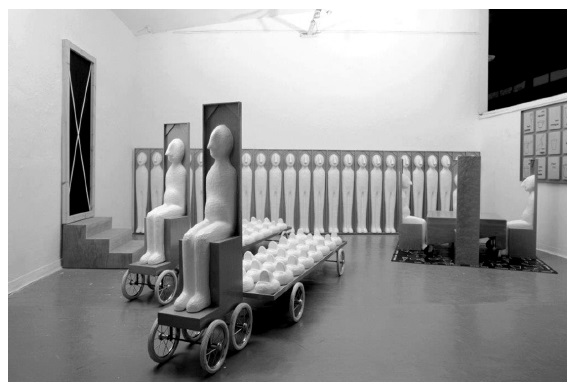
Copyright: Tzila Liss. Photography: Tal Mende. Source: Shadmon (2015: 76).
Figure 10 Tzila Liss, “Travelling through Fragmented Time”, 2002, installation, mixed media, The Peace Gallery, Givat Haviva
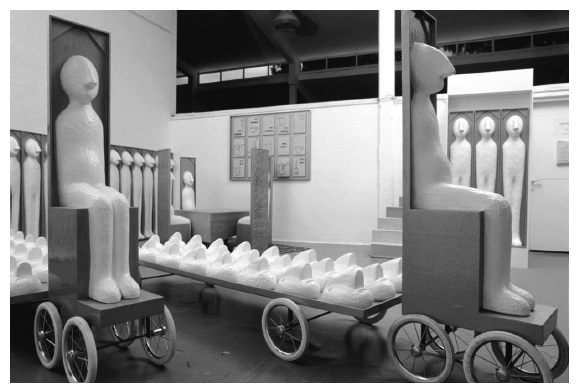
Copyright: Tzila Liss. Photography: Tal Mende. Source: Shadmon (2015: 79).
Figure 11 Tzila Liss, “Travelling through Fragmented Time”, 2002, installation, mixed media, The Peace Gallery, Givat Haviva
Conclusion
The artworks of Tzila Liss, Marion Fuchs and Idit Levavi Gabbai demonstrate expressions of genderlessness in kibbutz life by presenting men and women with a unified appearance. These artistic expressions are another layer of this paper’s analysis of degendered norms in kibbutz society, including a social-historic analysis of the role and status of kibbutz women artists. The role and status of kibbutz artists, as specified at the founding conference of the Association of Kibbutz Painters and Sculptors in 1935, created both in theory and in practice an equal approach towards male and female kibbutz artists by kibbutz leadership and kibbutz institutions.
This paper has demonstrated how classical kibbutz society can be addressed and used as an example of a socially just society in terms of gender towards its women artists, according to Erik Olin Wright’s definition and analysis of social justice and genderlessness. This paper did not take upon itself the task of claiming that women on kibbutz, in general, experienced social justice, but argued that women artists had equal social justice in comparison to their male artist counterparts, and even took this notion a step forward by arguing that the social status, role and artworks of women artists on kibbutz express genderlessness.
The paper started with analyzing how Wright defined a social just society and genderlessness. Then, through social-historical examination using archival evidence and based on personal interviews conducted with artists, the paper claimed that Wright’s definitions corresponded the social status and role of kibbutz women artists. Afterwards, using artistic analysis, the paper asserted that genderlessness is also expressed as a theme in artworks of kibbutz women artists. These methods supplied an interdisciplinary understanding of how the kibbutz, at least from the aspect of its artists, should be used as an example of a genderless society, in accordance with Wright’s thought. Hopefully this paper will encourage further studies intersecting Wright’s theories and kibbutz research, an intersection that can offer new understandings and insights with respect to kibbutz life.















